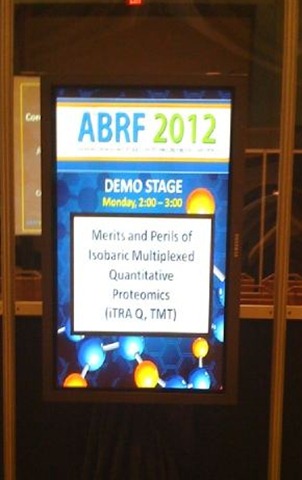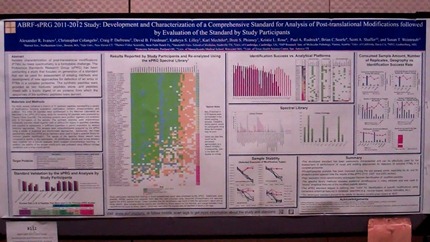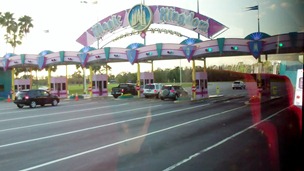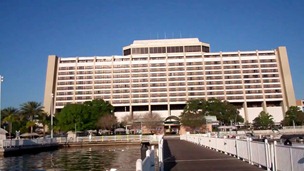The theme of this year’s ABRF meeting was the technology behind the stories, which all good science communications should tell. Core facility managers and staff, mainly from North America but others from all over the world, came together in Disney’s Contemporary Resort, Orlando, Florida to learn about the technologies available to support them. It was also an opportunity to get together and share experiences of running core operations.
The talks were broadly split equally into a genomics and proteomics focus. Our interest and involvement was in quantitative proteomics. The meeting covered the challenges it poses for core facility managers and their customers as well as the solutions to support designing and running quantitative proteomics experiments.
 The majority of the talks covered labelling and label-free strategies for LC-MS/MS.
The majority of the talks covered labelling and label-free strategies for LC-MS/MS.
Shabaz Mohammed (Biomolecular Mass Spectrometry & Proteomics group, Utrecht University) and Karl Mechtler (Mass Spectrometry & Protein Chemistry, Research Institute of Molecular Pathology, Vienna) each gave presentations based on labelling strategies. The first compared SILAC, dimethyl and TMT labelling using the criteria of (a) number of identified proteins (b) part of the proteome that is accessible (c) precision. While there was a high correlation between all three, TMT came out as the relative winner, especially in terms of precision. However, it was also stressed that chemical noise is an issue for all three labelling strategies, which affects reliable quantitation.
Karl’s presentation focussed on the use of iTRAQ but his first slide showed the rapid rise of label-free quantification. Based on the number of publications, the use of label-free techniques was projected above all the labelling strategies in 2012.
The use of label-free quantitative LC-MS is of interest to many core facilities due to it’s relatively low cost. Spectral counting was presented as the simplest way to achieve this, especially when you just want to compare lists of proteins present/absent between groups. However, while this broad view is relatively easy to achieve it generates more questions than answers for core facility customers. This is when ion intensity based label-free quantitation can help get more from your data.
We hosted a tutorial session including a presentation by Julian Whitelegge from UCLA covering this topic. He shared his experiences of translating facility users from relatively simple protein identification experiments to more sophisticated label-free quantification experiments based on ion intensity. It generated the most questions in the session and concluded that:
- Quantitative proteomics is an educational process
- There are many challenges to successful analyses in real biomedical experiments but…
- Powerful tools, including Progenesis LC-MS, are available to help, although samples must meet reasonable standards
- Experimental design must include statistical considerations
Over 60 people turned up to hear Julian talk as well as the other two presenters. We started with Will Dracup, from Nonlinear Dynamics and Biosignatures. He set the scene talking about the fundamental challenges you face with any quantitative proteomics experiment and how to overcome them. This was based on the messages we have developed as part of the Fixing Proteomics Campaign. After Julian’s presentation, Juan Chavez from the Bruce Lab, University of Washington finished the session with a talk on considerations for quantitative proteomics data. This focussed on the use of randomisation to eliminate bias, using enough replicates to build statistical power and how to select the right significance threshold. All these talks will be made available on the ABRF website shortly.
Posters
As well as the main programme there were 100 posters displayed. The Research Groups, for which ABRF is well known, presented results of their latest studies. These included posters from:
- Proteomics Standards Research Rroup with the development of a standard to support PTM analysis
- Antibody Technology Research Group showing the challenges of finding the “perfect” antibody
- Proteomics Research Group cataloguing the critical variables that influence LC-MS/MS data quality
There was a common theme of quality control and the use of standards covered in other posters. Notably, two from ProteoRed who have become synonymous with running multi-centre proteomics studies. They demonstrated metrics and approaches you can use to benchmark your LC-MS/MS and SRM systems. Alex Campos from the Proteomics Core Facility, won one of four Waters sponsored ABRF poster awards for the poster “ProteoRed MultiCenter Experiment for Long-term Quality Control Evaluation of Proteomics Core Facilities.”
The venue
It would be hard to talk about ABRF 2012 without mentioning its location, The Walt Disney World Resort. It was a great experience being there but hard to stay focussed on the science with so many fun distractions around. However, since the theme of the conference was the technology behind the stories, Disney was a relevant location! You can see pictures of the event with the official ABRF photos. Next year the meeting will be held in Palm Springs, California (March 2-5, 2013) and the focus will be tools for the advancement of converging science.





